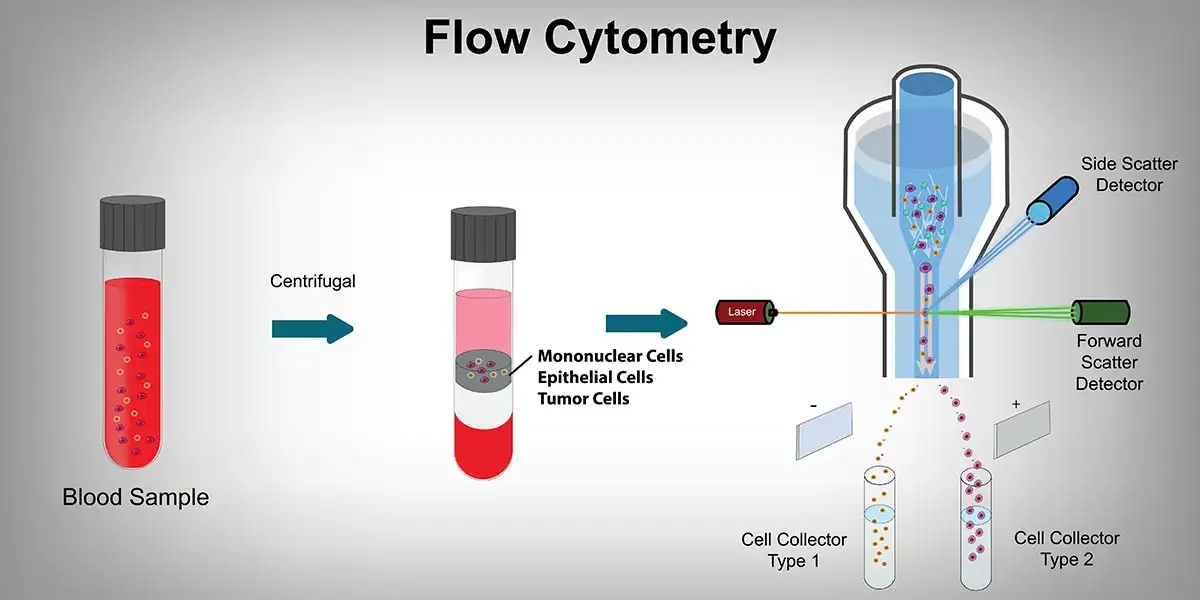Flow Cytometry (FC)

Flow Cytometry (FC): Principles, Applications, and Advances
Flow Cytometry (FC) is a powerful, laser-based technology used to analyze the physical and chemical characteristics of cells or particles in a fluid suspension. It has become an essential tool in research, diagnostics, and clinical practice due to its ability to rapidly provide multi-parametric data on individual cells. Below is a detailed overview of its principles, applications, and recent innovations.
Principles of Flow Cytometry
Core Components:
- Fluidics System: Hydrodynamically focuses cells into a single-file stream as they pass through the flow cytometer.
- Optical System: Uses lasers to excite fluorescently labeled molecules on or within cells. Light scatter (forward scatter for size, side scatter for granularity) and fluorescence are detected by photomultiplier tubes (PMTs).
- Electronics System: Converts light signals into electronic signals, which are analyzed and visualized using specialized software.
Detection Parameters:
- Forward Scatter (FSC): Measures cell size.
- Side Scatter (SSC): Indicates cell granularity or internal complexity.
- Fluorescence Intensity: Detects specific markers using fluorophore-conjugated antibodies or dyes.
Applications of Flow Cytometry
Research Applications:
- Immunophenotyping: Identification of cell types based on surface or intracellular markers (e.g., T-cell subsets using CD3, CD4, CD8 markers).
- Cell Cycle Analysis: Using DNA-binding dyes like propidium iodide to study cell proliferation.
- Apoptosis Detection: Assessing programmed cell death via annexin V staining or caspase activity assays.
Clinical Diagnostics:
- Hematologic Disorders: Diagnosing leukemia, lymphoma, and other blood cancers by identifying abnormal cell populations.
- Immunodeficiencies: Evaluating immune cell counts and functions in conditions like HIV/AIDS.
- Autoimmune Diseases: Analyzing white blood cell subtypes to assess immune dysregulation.
Therapeutic Monitoring:
- Tracking residual disease in cancer patients post-treatment.
- Monitoring response to immunotherapies or vaccines by measuring immune activation markers.
Microbial Studies:
- Detecting microorganisms like bacteria, fungi, or viruses in clinical samples using fluorescent probes or antibodies.
Advantages of Flow Cytometry
- Rapid analysis of thousands of cells per second.
- High sensitivity and specificity for detecting rare populations.
- Multi-parametric analysis allows simultaneous measurement of multiple markers.
- Ability to sort cells (Fluorescence-Activated Cell Sorting, FACS) for downstream applications like genomic studies.
Recent Innovations in Flow Cytometry
- Multicolor Flow Cytometry: Enables simultaneous detection of multiple markers using advanced fluorophores with minimal spectral overlap[2][8].
- Time-Resolved Flow Cytometry (TRFC): Improves sensitivity by distinguishing fluorophores based on fluorescence lifetime rather than spectral properties[6].
- Mass Cytometry (CyTOF): Uses metal isotopes instead of fluorophores for labeling, allowing analysis of up to 40+ parameters per cell with minimal signal overlap[8].
- Automation and AI Integration: Enhances data processing speed and accuracy while reducing manual errors[7].
Challenges
- High cost of instruments and reagents.
- Requires technical expertise for operation and data interpretation.
- Sensitivity to sample preparation quality; only viable cells can be analyzed effectively[4].
Conclusion
Flow cytometry is an indispensable tool in modern biology and medicine, offering unparalleled insights into cellular characteristics and functions. Its applications span immunology, oncology, infectious diseases, and beyond, with ongoing innovations like mass cytometry and AI integration promising even greater utility in the future.
Consult with Our Team of Experts Now!
At DrStemCellsThailand (DRSCT)‘s Anti-Aging and Regenerative Medicine Center of Thailand, we emphasize comprehensive evaluations and personalized treatment plans of Cellular Therapy and Stem Cells for managing various health conditions. If you have questions about Flow Cytometry (FC) or would like more information on our services, consult with our experts today!
Consult with Our Team of Experts Now!
References
- Title: Advances in Flow Cytometry: A Review of Recent Developments and Applications
DOI: 10.3389/fcell.2023.1008321
Summary: This review discusses recent advancements in flow cytometry, including spectral flow cytometry, nanoparticle cytometry, and droplet cytometry, highlighting their applications in cell biology and clinical diagnostics. - Title: Flow Cytometry in the Era of Single-Cell Analysis: Challenges and Opportunities
DOI: 10.1016/j.cels.2022.12.002
Summary: Explores the role of flow cytometry in single-cell analysis, focusing on its integration with emerging technologies like mass cytometry and its implications for personalized medicine. - Title: Mass Cytometry: A New Frontier in Cell Biology and Immunology
DOI: 10.1038/s41592-021-01254-5
Summary: Discusses the principles and applications of mass cytometry, highlighting its ability to analyze multiple parameters simultaneously and its potential in understanding complex cellular interactions.















